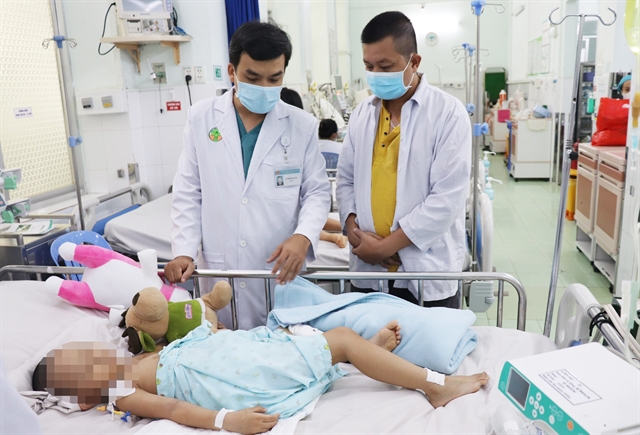 Society
Society

 |
| A child patient infected with hand, foot and mouth disease (HFMD) is treated at Children’s Hospital No 2 in HCM City. — VNA/VNS Photo |
HCM CITY — Many cases of hand, foot and mouth disease (HFMD) among children in HCM City are showing severe symptoms, with some requiring mechanical ventilation.
The Children’s Hospital No 2 in HCM City is attending to a large number of child patients infected with the disease, Sức khỏe & Đời sống (Health & Life) newspaper reports.
Nguyễn Ngọc Lâm, parent of a patient, said that last Saturday his daughter was running a 38.5 Celsius degree fever, with blisters spreading from her hand to all over her body within hours of onset.
After she was admitted to the hospital, she began having rapid pulse and apnea episodes, which required endotracheal intubation.
Lâm said: “She no longer has to stay in intensive care, but within only a few days she lost so much weight, I feel so much pity for her.”
Dr Trần Ngọc Lưu said that the hospital’s intensive care unit for infectious diseases and COVID-19 is attending to more than 150 patients, of which over 130 are HFMD cases.
The hospital has had to use foldable beds and made use of the hallways to make sure that each child patient has their own bed.
At the city’s Children’s Hospital 1, Dr Phùng Nguyễn Thế Nguyên said that there are also around 140 child patients with HFMD in their care.
Dr Nguyên, who is the hospital’s head of the intensive care unit for infectious diseases, said that three out of eight HFMD patients in their department need mechanical ventilation.
Meanwhile, the hospital also receives new patients infected with the disease on a daily basis. They are usually hospitalised for seven to ten days.
Dr Nguyên added that statistics and observation show that the HFMD is currently at its peak with no sign of decreasing.
He noted that this year, many of the child patients don’t experience high fever but still have severe illness, with more cases of apnea and requiring endotracheal intubation, compared to the previous years.
In 2011, HFMD caused death in approximately 150 children, but there were not as many cases requiring endotracheal intubation as today, Nguyên said.
According to the HCM City Centre for Disease Control (CDC), the city recorded 2,665 HFMD cases during the week of July 24-30, an increase of 1.4 times compared to the average of the previous four weeks.
The rising number of cases is reported in 21 out of the 22 districts in the city (except for Cần Giờ), with hotspots in Bình Tân, Bình Chánh and Tân Phú districts.
Doctors said that one of the main reasons for the early arrival and severity of HFMD this year is the EV71 virus strain, which also caused major outbreaks in 2011 and 2018.
HCM City Department of Health has issued a warning to strengthen solutions for disease prevention, as the number of cases is predicted to continue rising in the near future.
Dr Lưu said that signs of the disease in children include fever, mouth ulcers, and blisters in hand palms, foot soles, knees and elbows.
Dr Nguyên recommends that parents and schools take preventive measures by ensuring hygiene and quarantining children who are infected.
Patients should be examined at healthcare facilities for detailed monitoring and care instructions for prompt treatment.
Dr Nguyên added: “Parents should not be too worried because not every case is severe.
“They should not panic if they see HFMD infections, nor should they neglect to monitor the signs.”
According to HCM City’s health sector, the disease could continue for another three or four months.
The beginning of the school year is usually the peak of HFMD, therefore it is also necessary to strengthen preventive measures to avoid outbreaks.
The city’s health department recommends that people, especially families with children under five, should regularly wash their hands with soap and clean the surfaces and objects that children come into contact with every day.
They should look out for symptoms and take the child to the nearest medical facilities if they show signs of illness. — VNS




